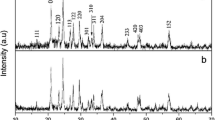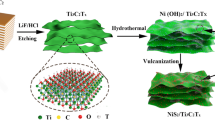Abstract
Ti2Nb10O29/C nanoparticles with a carbon content of 13 wt% and a mean size of 50 nm were fabricated through a convenient and effective in situ sol–gel process. The small grain size and carbon modification can improve the pseudocapacitive effect of the Ti2Nb10O29/C nanoparticles, leading to excellent rate capacity, especially at high current rate. Specifically, the discharge capacity of the Ti2Nb10O29/C electrode is 258.3, 236.0, 216.6, 184.5 and 161.5 mAh·g−1 at different current densities of 1C, 5C, 10C, 20C and 30C. Nevertheless, the discharge capacity of the Ti2Nb10O29 electrode is 244.9 mAh·g−1 at 1C, which is rapidly reduced to 89.7 mAh·g−1 at 30C. In addition, the small size and carbon layer of the Ti2Nb10O29/C nanoparticles can supply abundant active sites for Li+ storage as well as enhance the electronic conductivity and Li+ diffusion, endowing these nanoparticles with a high discharge capacity and excellent cycle performance.
Graphic abstract









Similar content being viewed by others
References
Yan Z, Yang QW, Wang Q, Ma J. Nitrogen doped porous carbon as excellent dual anodes for Li- and Na-ion batteries. Chin Chem Lett. 2020;31(2):583.
Wang X, Meng Q, Wang Y, Liang H, Bai Z, Wang K, Lou X, Cai B, Yang L. TiO2 hierarchical hollow microspheres with different size for application as anodes in high-performance lithium storage. Appl Energy. 2016;175:488.
Peled E, Golodnitsky D, Ardel G. Advanced model for solid electrolyte interphase electrodes in liquid and polymer electrolytes. J Electrochem Soc. 1997;144(8):L208.
Hu L, Luo L, Tang L, Lin C, Li R, Chen Y. Ti2Nb2xO4+5x anode materials for lithium-ion batteries: a comprehensive review. J Mater Chem A. 2018;6(21):9799.
Aravindan V, Sundaramurthy J, Jain A, Kumar PS, Ling WC, Ramakrishna S, Srinivasan MP, Madhavi S. Unveiling TiNb2O7 as an insertion anode for lithium ion capacitors with high energy and power density. Chem Sus Chem. 2014;7(7):1858.
Lin C, Yu S, Zhao H, Wu S, Wang G, Yu L, Li Y, Zhu JJ, Li J, Lin S. Defective Ti2Nb10O27.1: an advanced anode material for lithium-ion batteries. Sci Rep. 2015;5:17836.
Liao J, Ni W, Wang C, Ma J. Layer-structured niobium oxides and their analogues for advanced hybrid capacitors. Chem Eng J. 2019. https://doi.org/10.1016/j.cej.2019.123489.
Li J, Yang JY, Wang JT, Lu SG. A scalable synthesis of silicon nanoparticles as high-performance anode material for lithium-ion batteries. Rare Met. 2019;36(3):199.
Li J, Liu WW, Zhou HM, Liu ZZ, Chen BR, Sun WJ. Anode material NbO for Li-ion battery and its electrochemical properties. Rare Met. 2018;37(2):118.
Lou S, Cheng X, Gao J, Li Q, Wang L, Cao Y, Ma Y, Zuo P, Gao Y, Du C, Huo H, Yin G. Pseudocapacitive Li+ intercalation in porous Ti2Nb10O29 nanospheres enables ultra-fast lithium storage. Energy Storage Mater. 2018;11:57.
Tong Z, Xu H, Liu G, Zhao J, Li Y. Pseudocapacitive effect and Li+ diffusion coefficient in three-dimensionally ordered macroporous vanadium oxide for energy storage. Electrochem Commun. 2016;69:46.
Li Y, Zheng Y, Yao J, Xiao J, Yang J, Xiao S. Facile synthesis of nanocrystalline-assembled nest-like NiO hollow microspheres with superior lithium storage performance. RSC Adv. 2017;7(50):31287.
Wang HE, Zhao X, Xin K, Li Y, Chen L, Yang X, Zhang W, Su BL, Cao G. Superior pseudocapacitive lithium-ion storage in porous vanadium oxides@C heterostructure composite. ACS Appl Mater Inter. 2017;9(50):43665.
Lübke M, Shin J, Marchand P, Brett D, Shearing P, Liu Z, Darr JA. Highly pseudocapacitive Nb-doped TiO2 high power anodes for lithium-ion batteries. J Mater Chem A. 2015;3:22908.
Liu X, Liu M, Hu Y, Hu M, Duan X, Liu G, Ma J. Mesoporous Ti2Nb10O29 microspheres constructed by interconnected nanoparticles as high performance anode material for lithium ion batteries. Ceram Int. 2019;45(3):3574.
Liu G, Jin B, Bao K, Liu Y, Xie H, Hu M, Zhang R, Jiang Q. Facile fabrication of porous Ti2Nb10O29 microspheres for high-rate lithium storage applications. Int J Hydrog Energy. 2017;42(36):22965.
Fu Q, Hou J, Lu R, Lin C, Ma Y, Li J, Chen Y. Electrospun Ti2Nb10O29 hollow nanofibers as high-performance anode materials for lithium-ion batteries. Mater Lett. 2018;214:60.
Cong DP, Kim J, Tran VT, Kim SJ, Jeong SY, Choi JH, Cho CR. Electrochemical behavior of interconnected Ti2Nb10O29 nanoparticles for high-power Li-ion battery anodes. Electrochim Acta. 2017;236:451.
Sun Y, Liu X, Huang F, Li S, Shen Y, Xie A. Spinach juice-derived porous Fe2O3/carbon nanorods as superior anodes for lithium-ion batteries. Mater Res Bull. 2017;95:321.
Li H, Zhou H. Enhancing the performances of Li-ion batteries by carbon-coating: present and future. Chem Commun. 2012;48(9):1201.
Sun J, Teng D, Liu Y, Chi C, Yu Y, Lan J, Yang X. Enhanced lithium storage capability of a dual-phase Li4Ti5O12-TiO2-carbon nanofiber anode with interfacial pseudocapacitive effect. RSC Adv. 2014;4:48632.
Liu G, Jin B, Zhang R, Bao K, Xie H, Guo J, Wei M, Jiang Q. Synthesis of Ti2Nb10O29/C composite as an anode material for lithium-ion batteries. Int J Hydrog Energy. 2016;41(33):14807.
Wan G, Yang L, Shi S, Tang Y, Xu X, Wang G. Ti2Nb10O29 microspheres coated with ultrathin N-doped carbon layers by atomic layer deposition for enhanced lithium storage. Chem Commun. 2019;55(4):517.
Liu X, Wang H, Zhang S, Liu G, Xie H, Ma J. Design of well-defined porous Ti2Nb10O29/C microspheres assembled from nanoparticles as anode materials for high-rate lithium ion batteries. Electrochim Acta. 2018;292:759.
Huang SZ, Zhang Q, Yu W, Yang XY, Wang C, Li Y, Su BL. Grain boundaries enriched hierarchically mesoporous MnO/carbon microspheres for superior lithium ion battery anode. Electrochim Acta. 2016;222:561.
Ferrari AC, Robertson J. Interpretation of Raman spectra of disordered and amorphous carbon. Phys Rev B. 2000;61(20):14095.
Ma C, Zhang W, He YS, Gong Q, Che H, Ma ZF. Carbon coated SnO2 nanoparticles anchored on CNT as a superior anode material for lithium-ion batteries. Nanoscale. 2016;8:4121.
Yao L, Hou X, Hu S, Wang J, Li M, Su C, Tade MO, Shao Z, Liu X. Green synthesis of mesoporous ZnFe2O4/C composite microspheres as superior anode materials for lithium-ion batteries. J Power Source. 2014;258:305.
Wang YX, Yang J, Chou SL, Liu HK, Zhang WX, Zhao D, Dou SX. Uniform yolk-shell iron sulfide-carbon nanospheres for superior sodium-iron sulfide batteries. Nature Commun. 2015;6:8689.
Liu G, Liu X, Wang L, Ma J, Xie H, Ji X, Guo J, Zhang R. Hierarchical Li4Ti5O12-TiO2 microspheres assembled from nanoflakes with exposed Li4Ti5O12 (011) and anatase TiO2 (001) facets for high-performance lithium-ion batteries. Electrochim Acta. 2016;222:1103.
Liu H, Zhang Z, Hu L, Gao N, Sang L, Liao M, Ma R, Xu F, Fang X. New UV-A photodetector based on individual potassium niobate nanowires with high performance. Adv Opt Mater. 2014;2(8):771.
Tan BJ, Klabunde KJ, Sherwood PMA. Layered cobalt-manganese particles on alumina and silica. J Am Chem Soc. 1991;113(3):855.
Hou BH, Wang YY, Guo JZ, Ning QL, Xi XT, Pang WL, Cao AM, Wang X, Zhang JP, Wu XL. Pseudocapacitance-boosted ultrafast Na storage in a pie-like FeS@C nanohybrid as an advanced anode material for sodium-ion full batteries. Nanoscale. 2018;10:9218.
Chen Y, Xia H, Lu L, Xue J. Synthesis of porous hollow Fe3O4 beads and their applications in lithium ion batteries. J Mater Chem. 2012;22(11):5006.
Roh HK, Kim HK, Kim MS, Kim DH, Chung KY, Roh KC, Kim KB. In-situ synthesis of chemically bonded NaTi2(PO4)3/rGO 2D nanocomposite for high-rate sodium-ion batteries. Nano Res. 2016;6:1844.
Kaowphong S, Chumha N, Nimmanpipug P, Kittiwachana S. Nanosized GdVO4 powders synthesized by sol-gel method using different carboxylic acids. Rare Met. 2018;37(7):561.
Jiang ZY, Zhu KR, Lin ZQ, Jin SW, Li G. Structure and Raman scattering of Mg-doped ZnO nanoparticles prepared by sol-gel method. Rare Met. 2018;37(10):881.
Zhu X, Pei L, Zhu R, Yu J, Tang R, Wei F. Preparation and characterization of Sn/La co-doped TiO2 nanomaterials and their phase transformation and photocatalytic activity. Sci Rep. 2018;8:12387.
Ouzzine M, Maciá-Agulló JA, Lillo-Ródenas MA, Quijada C, Linares-Solano A. Synthesis of high surface area TiO2 nanoparticles by mild acid treatment with HCl or HI for photocatalytic propene oxidation. Appl Catal B-Environ. 2014;154–155:285.
Jiang C, Ichihara M, Honma I, Zhou H. Effect of particle dispersion on high rate performance of nano-sized Li4Ti5O12 anode. Electrochim Acta. 2007;52(23):6470.
Viet AL, Reddy MV, Jose R, Chowdari BVR, Ramakrishna S. Nanostructured Nb2O5 polymorphs by electrospinning for rechargeable lithium batteries. J Phys Chem C. 2010;114(1):664.
Deng S, Luo Z, Liu Y, Lou X, Lin C, Yang C, Zhao H, Zheng P, Sun Z, Li J, Wang N, Wu H. Ti2Nb10O29-x mesoporous microspheres as promising anode materials for high-performance lithium-ion batteries. J Power Sources. 2017;362:250.
Xiao C, He P, Ren J, Yue M, Huang Y, He X. Walnut-structure Si-G/C materials with high coulombic efficiency for long-life lithium ion batteries. RSC Adv. 2018;8:27580.
Jung BY, Lim HS, Sun YK, Suh KD. Synthesis of Fe3O4/C composite microspheres for a high performance lithium-ion battery anode. J Power Sources. 2013;244:177.
Li X, Jiang YZ, Li XK, Jiang HX, Liu JL, Feng J, Lin SB, Guan X. Electrochemical properties of LiFePO4/C composite cathode with different carbon sources. Rare Met. 2018;37(9):743.
Jiao X, Hao Q, Xia X, Yao D, Ouyang Y, Lei W. Boosting long-cycle-life energy storage with holey graphene supported TiNb2O7 network nanostructure for lithium ion hybrid supercapacitors. J Power Sources. 2018;403:66.
Jo C, Kim Y, Hwang J, Shim J, Chun J, Lee J. Block copolymer directed ordered mesostructured TiNb2O7 multimetallic oxide constructed of nanocrystals as high power Li-ion battery anodes. Chem Mater. 2014;26(11):3508.
Sun YG, Sun TQ, Lin XJ, Tao XS, Zhang D, Zeng C, Cao AM, Wan LJ. Facile synthesis of hollow Ti2Nb10O29 microspheres for high-rate anode of Li-ion batteries. Sci China Chem. 2018;61(6):670.
Zhang Z, Li Q, Li Z, Ma J, Li C, Yin L, Gao X. Partially reducing reaction tailored mesoporous 3D carbon coated NiCo-NiCoO2/carbon xerogel hybrids as anode materials for lithium ion battery with enhanced electrochemical performance. Electrochim Acta. 2016;203:117.
Madram AR, Daneshtalab R, Sovizi MR. Effect of Na+ and K+ co-doping on the structure and electrochemical behaviors of LiFePO4/C cathode material for lithium-ion batteries. RSC Adv. 2016;6:101477.
Wang GJ, Qu QT, Wang B, Shi Y, Tian S, Wu YP, Holze R. Electrochemical intercalation of lithium ions into LiV3O8 in an aqueous electrolyte. J Power Sources. 2009;189:503.
Mao W, Liu K, Guo G, Liu G, Bao K, Guo J, Hu M, Wang W, Li B. Preparation and electrochemical performance of Ti2Nb10O29/Ag composite as anode materials for lithium ion batteries. Electrochim Acta. 2017;253:396.
Ashish AG, Arunkumar P, Babu B, Manikandan P, Sarang S, Shaijumon MM. TiNb2O7/Graphene hybrid material as high performance anode for lithium-ion batteries. Electrochim Acta. 2015;176:285.
Zhu K, Wang Q, Kim JH, Pesaran AA, Frank AJ. Pseudocapacitive lithium-ion storage in oriented anatase TiO2 nanotube arrays. J Phys Chem C. 2012;116(22):11895.
Wang J, Polleux J, Lim J, Dunn B. Pseudocapacitive contributions to electrochemical energy storage in TiO2 (anatase) nanoparticles. J Phys Chem C. 2007;111(40):14925.
Lindström H, Södergren S, Solbrand A, Rensmo H, Hjelm J, Hagfeldt A, Lindquist SE. Li+ ion insertion in TiO2 (anatase). 2. Voltammetry on nanoporous films. J Phys Chem B. 1997;101(39):7717.
Yang C, Zhang Y, Lv F, Lin C, Liu Y, Wang K, Feng J, Wang X, Chen Y, Li J, Guo S. Porous ZrNb24O62 nanowires with pseudocapacitive behavior achieve high performance lithium-ion storage. J Mater Chem A. 2017;5(42):22297.
Cook JB, Kim HS, Yan Y, Ko JS, Robbennolt S, Dunn B, Tolbert SH. Mesoporous MoS2 as a transition metal dichalcogenide exhibiting pseudocapacitive Li and Na-ion charge storage. Adv Energy Mater. 2016;6(9):1501937.
Acknowledgments
This study was financially supported by the National Natural Science Foundation of China (No. 51802163), the National Natural Science Foundation of Henan Department of Education (No. 20A480004) and the China Postdoctoral Science Foundation (No. 2017M622564).
Author information
Authors and Affiliations
Corresponding author
Electronic supplementary material
Below is the link to the electronic supplementary material.
Rights and permissions
About this article
Cite this article
Liu, GY., Zhao, YY., Tang, YF. et al. In situ sol–gel synthesis of Ti2Nb10O29/C nanoparticles with enhanced pseudocapacitive contribution for a high-rate lithium-ion battery. Rare Met. 39, 1063–1071 (2020). https://doi.org/10.1007/s12598-020-01462-w
Received:
Revised:
Accepted:
Published:
Issue Date:
DOI: https://doi.org/10.1007/s12598-020-01462-w




